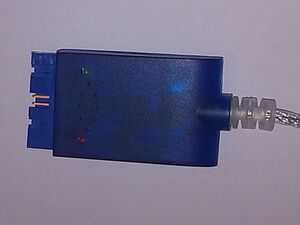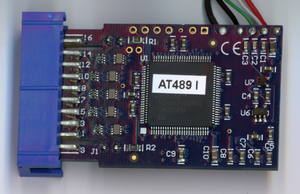Difference between revisions of "RockyLogic Ant18e"
Uwe Hermann (talk | contribs) m (→Protocol) |
|||
| Line 1: | Line 1: | ||
[[File:Ant18e closed.jpg|thumb|right|RockyLogic Ant18e]] | [[File:Ant18e closed.jpg|thumb|right|RockyLogic Ant18e]] | ||
[[File: | [[File:ant18e-front2.png|thumb|right|PCB front]] | ||
[[File: | [[File:ant18e-back2.png|thumb|right|PCB back]] | ||
The [http://www.rockylogic.com/products/ant18e.html RockyLogic Ant18e] is a 1GHz logic analyzer. It has 18 probes and is powered via USB. | The [http://www.rockylogic.com/products/ant18e.html RockyLogic Ant18e] is a 1GHz logic analyzer. It has 18 probes and is powered via USB. | ||
Revision as of 22:09, 17 December 2011
The RockyLogic Ant18e is a 1GHz logic analyzer. It has 18 probes and is powered via USB.
See RockyLogic_Ant18e/Info for more details (such as lsusb -vvv output) about the device.
Components
- Xilinx XC3S200 (FPGA)
- Xilinx XC9572XL (CPLD)
- FTDI FT245RL (USB FIFO device)
- IDT 501MLF (clock multiplier)
- 25MHz crystal
Status
Support for this device is currently being worked on.
Protocol
The protocol for Ant8 / Ant16 / Ant18e seems to be very similar, so this section documents all variants.
Since the device uses an FTDI chip for USB communication with the host, the common endpoint configuration for devices like this is used: endpoint 1 for device-to-host communication, and endpoint 2 for host-to-device.
FPGA bitstreams
There is one "base" FPGA bitstream which likely implements the "quick sample mode" explained below. This bitstream is (re-)uploaded after every sampling run.
Before a sampling run at a given sampling rate, a special bitstream is uploaded (a different one for each samplerate, it seems).
Quick sample mode
This mode lets the host receive the status of all probes immediately. It's used by the original software to animate the "pins" display when a proper acquisition is not running.
The host sends a two-byte command (Ant18e: 0x19 0x92, Ant8: 0x19 0x88). The second bytes seems to have bit 7 always set to 1, and (some of) the remaining bits (6..0) encode the number of bytes/probes to get (18 for Ant18e, 8 for Ant8). We expect that the Ant16 uses 0x19 0x90 as command (not verified due to lack of Ant16 hardware).
The host then receives in return a number of bytes (Ant18e: 18 bytes, Ant8: 8 bytes) containing the state of all probes. Each byte has the information for one probe, encoded as follows:
- Bits 7-3 (7-4 on Ant8): The probe ID (Ant18e: 0-17, Ant8: 0-7); shift right by 3 bits (on Ant18e), or 4 bits (on Ant8).
- Bit 2: If 1/high, this means a falling edge occured on the respective probe(?)
- Bit 1: If 1/high, this means a rising edge occured on the respective probe(?)
- Bit 0: The state of the respective signal (0: low, 1: high).
Example on Ant8:
- Host sends: 0x19 0x88
- Host receives (for example):
- 0x00 0x10 0x20 0x30 0x40 0x50 0x60 0x70 (all 8 probes are low)
- 0x00 0x13 0x20 0x30 0x40 0x50 0x60 0x70 (probe 1 went from low to high == rising edge)
- 0x00 0x11 0x20 0x30 0x40 0x50 0x60 0x70 (probe 1 is high, and was high before too)
- 0x00 0x14 0x20 0x30 0x40 0x50 0x60 0x70 (probe 1 went from high to low == falling edge)
- 0x00 0x10 0x20 0x30 0x40 0x50 0x60 0x70 (probe 1 is low, and was low before too)
Starting a measurement
TODO
Measurement configuration
TODO: Triggers etc.
Retrieving samples
The host simply reads all samples from the device. The samples are given in the following format:
Ant8:
- There are exactly 3072 samples per run, each sample consisting of one byte, where bit 0 is the state (low/high) of probe 0, and bit 7 is the state of probe 7.
- There is no compression or "mangling" of the sample data.


